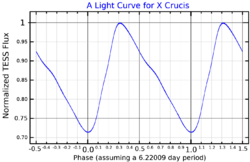Astronomy:X Crucis
| Observation data Equinox J2000.0]] (ICRS) | |
|---|---|
| Constellation | Crux |
| Right ascension | 12h 46m 22.2678s[2] |
| Declination | −59° 07′ 29.120″[2] |
| Apparent magnitude (V) | 8.1 - 8.7[3] |
| Characteristics | |
| Spectral type | G1Ib[4] |
| B−V color index | +0.87[5] |
| Variable type | δ Cep[3] |
| Astrometry | |
| Radial velocity (Rv) | -25.0[6] km/s |
| Proper motion (μ) | RA: -8.2[7] mas/yr Dec.: -0.9[7] mas/yr |
| Parallax (π) | 0.5235 ± 0.0459[8] mas |
| Distance | 6,200 ± 500 ly (1,900 ± 200 pc) |
| Absolute magnitude (MV) | −3.9[9] |
| Details | |
| Mass | 4.3[9] M☉ |
| Radius | 50[10] R☉ |
| Luminosity | 2,884[9] L☉ |
| Surface gravity (log g) | 1.69[9] cgs |
| Temperature | 5,180 - 6,029[11] K |
| Other designations | |
| Database references | |
| SIMBAD | data |
X Crucis is a classical Cepheid variable star in the southern constellation of Crux.
X Crucis is a pulsating variable star with am extremely regular amplitude and period. Its apparent magnitude varies from 8.1 to 8.7 every 6.22 days. This type of variable is known as a Cepheid after δ Cephei, the first example to be discovered. X Crucis is a population I star and so is a classical or type I Cepheid variable, to be distinguished from older low-mass stars called type II Cepheid variables.[3]
Classical Cepheids pulsate radially so that their size varies. X Crucis pulsates in its fundamental mode and its properties indicate that it is crossing the instability strip for the third time as its evolves back to cooler temperatures.[9] Its radius varies by about 5 R☉ during each cycle, approximately 8% of its mean radius. At the same time its temperature varies between 5,180 and 6,029 K. The radius and temperature do not vary in sync, with the smallest size occurring as the temperature is approaching its maximum. The brightness increases rapidly to a maximum when the star is hottest, then decreases more slowly. This is one of the properties that indicate fundamental mode pulsation.[10][11]
References
- ↑ "MAST: Barbara A. Mikulski Archive for Space Telescopes". Space Telescope Science Institute. https://mast.stsci.edu/portal/Mashup/Clients/Mast/Portal.html.
- ↑ 2.0 2.1 Hog, E.; Kuzmin, A.; Bastian, U.; Fabricius, C.; Kuimov, K.; Lindegren, L.; Makarov, V. V.; Roeser, S. (1998). "The TYCHO Reference Catalogue". Astronomy and Astrophysics 335: L65. Bibcode: 1998A&A...335L..65H.
- ↑ 3.0 3.1 3.2 Samus, N. N. et al. (2009). "VizieR Online Data Catalog: General Catalogue of Variable Stars (Samus+ 2007-2013)". VizieR On-line Data Catalog: B/GCVS. Originally Published in: 2009yCat....102025S 1. Bibcode: 2009yCat....102025S.
- ↑ Houk, Nancy (1979). Michigan catalogue of two-dimensional spectral types for the HD stars. 1. Ann Arbor: University of Michigan. Bibcode: 1978mcts.book.....H.
- ↑ Dean, J.F. (1977). "B, V, I, photometry of Southern Cepheids". University of Michigan Catalogue of Two-dimensional Spectral Types for the HD Stars. Volume I. Declinations -90_ to -53_ƒ0. Ann Arbor: University of Michigan. Bibcode: 1975mcts.book.....H.
- ↑ Evans, D. S. (1967). "The Revision of the General Catalogue of Radial Velocities". Determination of Radial Velocities and Their Applications 30: 57. Bibcode: 1967IAUS...30...57E.
- ↑ 7.0 7.1 Høg, E.; Fabricius, C.; Makarov, V. V.; Urban, S.; Corbin, T.; Wycoff, G.; Bastian, U.; Schwekendiek, P. et al. (2000). "The Tycho-2 catalogue of the 2.5 million brightest stars". Astronomy and Astrophysics 355: L27. Bibcode: 2000A&A...355L..27H.
- ↑ Brown, A. G. A. (August 2018). "Gaia Data Release 2: Summary of the contents and survey properties". Astronomy & Astrophysics 616: A1. doi:10.1051/0004-6361/201833051. Bibcode: 2018A&A...616A...1G. Gaia DR2 record for this source at VizieR.
- ↑ 9.0 9.1 9.2 9.3 9.4 Opolski, A. (1984). "Observational determination of pulsation modes and photometric masses of Cepheid variables". Acta Astronomica 34: 225. Bibcode: 1984AcA....34..225O.
- ↑ 10.0 10.1 Tsvetkov, Ts. G. (1988). "Absolute and relative amplitudes of variations in radius of classical Cepheids". Astrophysics and Space Science 150 (2): 223–234. doi:10.1007/BF00641718. Bibcode: 1988Ap&SS.150..223T.
- ↑ 11.0 11.1 Pel, J. W. (1978). "Intrinsic colours and physical properties of Cepheids". Astronomy and Astrophysics 62: 75. Bibcode: 1978A&A....62...75P.
 |


